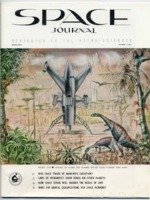
Browse Items (42 total)
Sort by:
-
Space Journal, vol. 1, no. 5, March-May 1959.
This issue includes a statement announcing Space Journal's termination of all connections with the U.S. military and with the Rocket City Astronomical Association. At the time, commander of the Army Ballistic Missile Agency (ABMA) at Redstone Arsenal Gen. John B. Medaris was concerned that the publishers and writers, all in the employ of ABMA, were using their government positions for personal gain through the magazine. Topics covered in the issue include the dangers and feasibility of space travel, designing buildings for life on the Moon, and the existence of life elsewhere in the universe. -
"After the Moon - What? Minutes of the Manned Flight Awareness Seminar."
The seminar was held at the Manned Spacecraft Center, September 25-26, 1969. -
"Application of the Saturn V Launch Vehicle to Unmanned Scientific Exploration of the Solar System."
According to the foreword, "This paper presents the results of a twelve-week mission and systems analysis of a combined Jupiter orbiter/solar probe mission utilizing the Saturn V launch vehicle." -
Artist's Conception of the RL10-powered Saturn S-IV Stage.
This artist's rendering of the RL10-powered Saturn S-IV stage is depicted as heading toward deep space after separation from the booster. The drawing is accompanied with a brief description of the Saturn S-IV. -
Saturn Illustrated Chronology, 1965
NASA and MSFC -
Oral History Interview With Allen Ware
Allen Ware is originally from Atlanta Georgia. He attended Auburn University where he studied Industrial Design . He moved to Huntsville, AL in 1983 to work for a company called "Essex." He worked there from 1983-1991. There, he produced a variety of things. First, he helped produce the Hubble Space Telescope mock-up and crew trainers. Then, he produced some other shuttle mock-ups. After leaving "Essex," he started to work at Boeing in Huntsville where he worked on the International Space Station. There, Ware was an internal and external packager configurator. He did that job for 15 years. He then transitioned to support the Delta IV launch vehicle out of Decatur. There, he did secondary structure design for Delta IV components. Ware is currently an Engineering manager of a Mechanical design team. He has about 15 engineers under him that do spacecraft, aircraft, and launch-vehicle design.Tags Oral History -
Oral History Interview With Joe Phillipauldy
Joe Phillipauldy is originally from Central, New Jersey. He did his undergraduate training at the University of Richmond in Virginia, and then he received his Master's degree at Villanove University. He then when on to get his graduate degree, and completed the program in 1984. His degree was in Experimental Psychology. In 1986, he accepted a job position with the Creatis Systems Tech Staff at Boeing Military Airplanes in Kansas. His first Human Engineering job was with Tech Staff. A project he spent a lot of time on was the Airforce I VC25 747 Presidential Replacement Program. With this, he did a workload analysis of the navigator crew station. After this work, Joe got involved with the Human Factors and Industrial Applications group. There, he ran task terms around the factory floor doing analyses and reporting on ergonomics issues on assembling vehicles. Later, he was able to work on the Space Station Vehicle Integration Contract in Huntsville, AL.Tags Oral History -
Oral History Interview With George Hamilton
George Hamilton has lived in Huntsville, Alabama all of his life, and his father was a Charter Marshall Member in Huntsville. When he was working, George's father was chosen as a "guinea pig" to go up in the Pregnant Guppy, which was a large, wide-bodied cargo aircraft. Because of George's father's career and interest with NASA, it made George interested in the career as well. George has a lot of family stories like this, which all have inspired him to take on his career that he has now. After high school, George went to The University of South Alabama in Mobile to study Marine Biology. Over the summer he had a change of heart, so he decided to transfer to Auburn University for Mechanical Engineering. After he finished up with his degree, he started working in small, manufacturing spare parts for missiles. After this career, he started to work at Avco Electronics in Huntsville where he worked at the plant on the design side. After this, Avco started looking for people to go overseas on the construction side of the house, so George went overseas with them. Then he came back, got married, and received his Phd in Biomedical Engineering at The University of Alabama in Birmingham.Tags Oral History







